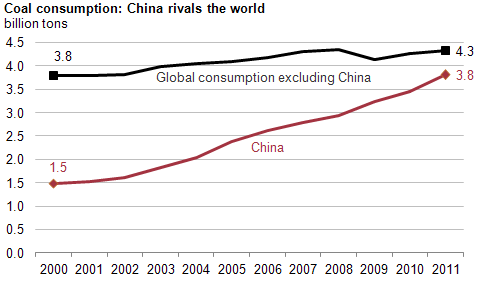The pollution in China has reached a critical level. One-third of the urban population breathes the contaminated air and, as a result, lung cancer is the number one cause of mortality in China. It has also been reported that acid rain falls on one-third of the country. The United Nations Environment Programme (UNEP) reported that nine of the world’s ten major air polluted cities (except Rajkot in India) are China’s big cities, such as Taiyuan, Lanzhou, and Chongqing. The reason why the air pollution problem has gotten worse is due to the use of coal. They get about 80% of energy from using coal. China is the world’s largest coal producer and consumer as well as accounting for one-third of world’s coal distribution.
The graph pictured shows that the coal consumption in China alone has reached the consumption level equal to that of the rest of the world. The coal consumption in China has risen to nearly 47% of the world’s coal consumption. In 2007, China had become the world’s largest carbon emitting country and became number one in energy consumption in 2010.
The government has taken a number of measures to keep the pollution level low,but this leads to low consumption of coal, which is critical to Chinese economy. The need of developing other forms of technology or resources has become an extremely important task for China.
Further Reading: Chosun (Korean Language), US-DOE EIS

See a previous post by Zack Westerman on the impact of ash (fine particles) and heavy metals, both of which are parts of coal plant effluents. But that post did not discuss acid rain, so this one complements it nicely.
As to lung cancer, tobacco is also a major contributor – maybe more important, and certainly the twin impact is really bad.
The negative affects of China’s pollution are a terrible problem that will need to be dealt with eventually. It comes down to lowering the pollution production of coal plants and other major contributing factors in the pollution production, or finding a way to somehow clean the air that the Chinese people breathe. Before and during the Beijing Olympics China put a lot of effort into cleaning the air so that the athletes could compete in the environment. I think this needs to be continued and put on the front burner because it doesn’t look like China will be decreasing their pollution production anytime soon.
China’s global agenda in regards to international trade includes their economic status, not their environmental impact. The country exploits its resources and has more people to manufacture goods, rather than services, thus it is primarily focused on the manufacturing sector of economic growth. China is currently a member of the Kyoto Protocol, which obligates contracting parties to reduce greenhouse emissions to 5% below 1990s levels by 2012, but China is one of many countries that does not have a binding target. However, this protocol does promote “emission trading,” which gives economic incentives for the reduction of pollutants. In a sense, it can be looked at as “free market environmentalism.”
According to one study, breathing city air on a smoggy day is “similar to smoking 21 cigarettes in Beijing, 25 in Guangzhou, 9 in Shanghai, 9 in Nanjing, 13 in Changsha, 12 in Chengdu and 13 in Wuhan,” thus there are very significant direct public health implications. Local cleaning of the air, through artificial water deposition (for soot) and carbon sequestration (for CO2) may somewhat rectify this issue, but that does nothing to help with soot and heavy metal deposition on/acidification of farmland and waterways or the larger contribution of carbon and methane to climate change, all of which pose arguably greater threats than urban air quality. China has already adopted so-called “clean coal” technology for many of its plants, but this is not enough–a hefty tax must be imposed on emissions so as to internalize their massive costs and prompt investment in alternative energy sources.
[…] wanted to follow up on my previous post. In this post, I will discuss China’s 12th “5-year-plan,” a major political […]
This problem is not only their problem now. This pollution affects not only the two Koreas, but also Japan and the U.S. west coast. Dust storm from China is detrimental to human health. It is really the time to work together to solve this problem. I do not think Chinese government itself can manage the problem now. In addition to reducing their coal consumption level, they should also ask for help for it as other countries are trying to help.
The dust may not be a modern problem; much of (arable) north China is loess [wind-blown] soil, so the issue goes back millennia. Heavy metals, acid rain, fine particulates and smog are new, but fortunately the latter are not an issue for the US. Not true for the Koreas, Taiwan, and Japan.
Korea now experiences the dust storm from China every beginning of Spring. This is a big concern form Koreans since dust storm causes lung cancers, etc.